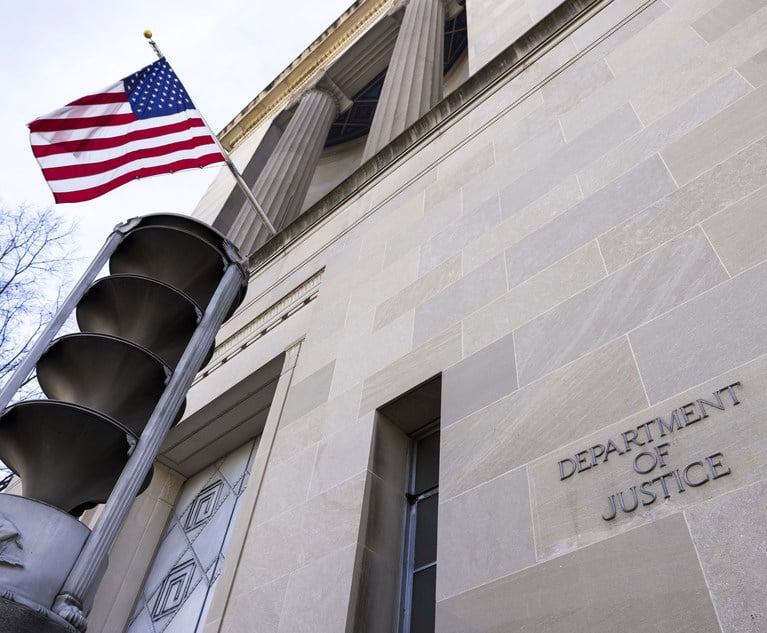 Kathleen A. Scott
Kathleen A. ScottProposed International Standards on Cooperation Between Prudential and Anti-Money Laundering Supervisors
In November 2019, the Basel Committee issued for comment a proposed annex to the AML Risk Management Guidelines on "interaction and cooperation between prudential and AML/CFT supervision." Comments on the proposed Supervision Annex are being accepted through February 6. In this edition of her International Banking column, Kathleen A. Scott discusses some of the main themes set forth in the document.
January 29, 2020 at 12:00 PM
9 minute read
In 2014, the Bank for International Settlement's Basel Committee on Banking Supervision (the Basel Committee), which proposes international banking standards, issued guidelines on "Sound management of risks related to money laundering and financing of terrorism" (AML Risk Management Guidelines). In 2017, they were revised to address Correspondent Banking and Account Opening Proceedings.
In November 2019, the Basel Committee issued for comment a proposed annex to the AML Risk Management Guidelines on "interaction and cooperation between prudential and AML/CFT supervision" (the Supervision Annex). Comments on the proposed Supervision Annex are being accepted through February 6. This month's column will discuss some of the main themes set forth in the document.
|Why Should Banks Care?
Why should banks care about better coordination and cooperation between banking regulators (the prudential supervisors) and the government agencies devoted to anti-money laundering and countering financing of terrorism (the AML/CFT supervisor)? Better cooperation between supervisors can mean that banks might anticipate a more uniform regulatory regime by not receiving advice from different supervisors that could conflict with each other. Better coordination also could serve as an educational tool for each supervisor to have a better idea of the other's regulatory priorities.
|What Is Being Proposed?
The AML Risk Management Guidelines themselves would be amended to add a paragraph to Section IV on the role of supervisors:
Prudential and AML/CFT supervisors should establish an effective cooperation mechanism regardless of the institutional setting, as set out in Annex 5 to ensure that [anti-money laundering and financing terrorism] risks are adequately supervised in the domestic and cross-jurisdictional context for the benefit of the two functions, without unduly duplicating efforts.
|General Provisions
The first section of proposed Annex V sets out the main differences between prudential regulation and AML/CFT regulation. Globally, prudential supervision is aimed at ensuring a safe and sound banking system, a broad mandate. Global AML/CFT regulation has a narrower, but equally important purpose: to ensure compliance with applicable laws and regulations on anti-money laundering and the countering of the financing of terrorism, including those laws and regulations applicable to banking organizations.
The Supervision Annex references the Financial Action Task Force (FATF), the international group of governments that proposes AML/CFT standards (referred to as Recommendations), and recommends that both sets of supervisors adopt practices outlined in the Recommendations on the roles of supervisors and information exchange in order to "appropriately consider" AML/CFT risk in their institutions.
Oftentimes, in bank supervision, the size of the institution comes into play when assessing its risk to the underlying financial system. The Supervision Annex makes the point that for purposes of assessing AML/CFT risk, size is not an appropriate standard; regardless of their size, banking organizations need to assess and address relevant AML/CFT risks.
Violating AML/CFT laws and regulations also could pose concerns for the prudential supervisors as well. For example, a major AML/CFT enforcement action against a banking organization could cause immense reputational damage leading to loss of customers and a limitation on willing counterparties for commercial transactions such as swaps and derivatives.
As described in more detail in the guidelines, the Supervision Annex highlights cooperation and information exchange as important in three areas:
- When a banking organization is first formed
- Ongoing supervision issues
- Supervisory enforcement actions, including revocation of a banking license
Cooperation and Exchange of Information
Authorization Process: When a group sets out to establish a new banking organization in a jurisdiction (or a domestic office of a bank not formed in that country), they need to submit significant amounts of documentation to the prudential supervisor, including a business plan, pro forma financials, and the credentials for proposed executive management.
The Supervision Annex described various ways AML/CFT Supervisors can work with prudential supervisors that are processing a new bank application, including the following:
- Do the proposed products, customer base and other parts of the business plan raise possible AML/CFT risks?
- If it is a bank from another country that is applying to establish a direct office or subsidiary in that country, what is the AML/CFT risk profile of the home jurisdiction (e.g., Does it abide by the Recommendations)?
- Does the proposed banking organization's projected AML/CFT compliance program and risk management oversight structure effectively address the risks identified by the prudential supervisor (as well as the proposed organization) and is the proposed AML/CFT compliance officer and staff competent for the task?
- What is the source of funds for the investment; are the proposed organization's anticipated major shareholder or shareholders subject to AML/CFT requirements and if so, what is the track record on their AML/CFT compliance?
- Are the proposed board members and executive officers "fit and proper" to take up their assigned positions (e.g., Has anyone been subject to an enforcement order for non-compliance with AML/CFT regulations)?
Ongoing Supervision: Part of the ongoing supervisory responsibilities for prudential supervisors over banking organizations includes evaluation of the banking organization's financial condition and determining whether it is in compliance with applicable law in a safe and sound manner. Weak AML/CFT controls certainly can have an impact on the safety and soundness of the banking organization.
The Supervision Annex sets out various ways in which the prudential supervisors and the AML/CFT supervisors should work together, including the following:
- Providing information on global AML/CFT concerns that might guide the prudential supervisor's risk assessment of that organization
- The AML/CFT supervisor could share its own examination reports of the banking organization with the relevant prudential supervisor to assist in pinpointing possible AML/CFT risks
- The prudential supervisor could share information with the AML/CFT supervisor on a banking organization, such as corporate governance structure, business plan, complex product offerings, past history of rejected acquisition applications and background information on board members and executive officers
- Sharing information on deficiencies in a banking organization's IT systems that could lead to weaknesses in the AML/CFT IT compliance systems
- Providing information from on-site examinations or analysis of required financial reports that might indicate potential AML/CFT violations
Enforcement Actions: This section addresses the recommended cooperation and coordination between prudential and AML/CFT supervisors during the enforcement action process.
Naturally, the first recommendation is that each supervisor keep the other informed, to the extent possible, of pending or proposed enforcement actions.
With respect to a planned or proposed AML/CFT enforcement action, such as one that could include financial penalties, it is recommended that the AML/CFT supervisor alert the prudential supervisor as soon as feasible so that the prudential regulator can evaluate the impact on the financial and operational impact on the banking organization, and whether the prudential regulator needs to take action on its own, such as curtailing business operations or even terminating a license to operate in the jurisdiction.
|Mechanisms for Cooperation
The final section encourages regular channels of communication among regulators and proposes various ways on how the supervisors can cooperate with each other, including the following:
- Entering into a formal Memorandum of Understanding (MoU) that describes the process for cooperation and information exchange, such as methods of information exchange, resolution of disputes, required data protection and confidentiality provisions, and addressing when multiple agencies want to investigate the same banking organization with a risk that one investigation might prejudice another investigation
- Develop a procedure for processing requests for information, including a process for the relevant supervisor to determine if the information is available and can legally be shared, and under what conditions a request might need to be denied
- Similar processes should be put into effect for cross-border sharing of information, including consideration of setting up a cross-border group of regulators to meet regularly to discuss matters of concern
- Consideration of whether there might be joint examinations of a particular banking organization, when such examination would be beneficial to both supervisors
- Establishing written policies and procedures to address situations where the information exchange will include a third party such as a law enforcement agency
- As noted above, a mechanism for information exchange must take into account applicable laws on confidentiality or data protection on what information can be shared within those restrictions, and compliance with any requirement to obtain permission from an entity whose information is being disclosed.
Conclusion
In the United States, the Financial Crimes Enforcement Network (FinCEN) is the AML/CFT supervisor. The prudential banking supervisors, depending upon the type of banking organization, can be the Board of Governors of the Federal Reserve System, the Federal Deposit Insurance Corporation, the Treasury Department's Office of the Comptroller of the Currency, the National Credit Union Administration or a state banking supervisor (collectively, the U.S. prudential supervisors).
FinCEN and the U.S. prudential supervisors have long worked together and FinCEN has delegated to the U.S. prudential supervisors the authority to examine banking organizations under their jurisdiction for compliance with applicable AML/CFT compliance. The U.S. prudential supervisors and FinCEN jointly issued an AML/CFT examination handbook that is very useful not only to regulatory agencies but also to relevant financial institutions.
U.S. prudential supervisors can bring enforcement actions against those banking organizations for violations of AML/CFT requirements, including imposition of civil penalties and mitigation actions. A bank not in compliance with applicable law can be a bank in an unsafe and unsound condition. Such enforcement actions may take the form of a joint U.S. prudential supervisory action between FinCEN and one or more of the U.S. prudential supervisors. Even if action is taken separately, it is expected that the agencies closely coordinate these actions.
Even with a good base of cooperation among U.S. regulators, there can always be room for improvement, and not every country has the same jurisdictional arrangement. Banking organizations should consider commenting on how better cooperation and coordination among their supervisors can translate into a more efficient supervisory system for them.
Kathleen A. Scott is a senior counsel in the New York Office of Norton Rose Fulbright.
This content has been archived. It is available through our partners, LexisNexis® and Bloomberg Law.
To view this content, please continue to their sites.
Not a Lexis Subscriber?
Subscribe Now
Not a Bloomberg Law Subscriber?
Subscribe Now
NOT FOR REPRINT
© 2025 ALM Global, LLC, All Rights Reserved. Request academic re-use from www.copyright.com. All other uses, submit a request to [email protected]. For more information visit Asset & Logo Licensing.
You Might Like
View All

Government Attorneys Are Flooding the Job Market, But Is There Room in Big Law?
4 minute read

Trump, ABC News Settlement in Defamation Lawsuit Includes $1M in Attorney Fees For President-Elect
Law Firms Mentioned
Trending Stories
- 1'Pull Back the Curtain': Ex-NFL Players Seek Discovery in Lawsuit Over League's Disability Plan
- 2Tensions Run High at Final Hearing Before Manhattan Congestion Pricing Takes Effect
- 3Improper Removal to Fed. Court Leads to $100K Bill for Blue Cross Blue Shield
- 4Michael Halpern, Beloved Key West Attorney, Dies at 72
- 5Burr & Forman, Smith Gambrell & Russell Promote More to Partner This Year
Who Got The Work
Michael G. Bongiorno, Andrew Scott Dulberg and Elizabeth E. Driscoll from Wilmer Cutler Pickering Hale and Dorr have stepped in to represent Symbotic Inc., an A.I.-enabled technology platform that focuses on increasing supply chain efficiency, and other defendants in a pending shareholder derivative lawsuit. The case, filed Oct. 2 in Massachusetts District Court by the Brown Law Firm on behalf of Stephen Austen, accuses certain officers and directors of misleading investors in regard to Symbotic's potential for margin growth by failing to disclose that the company was not equipped to timely deploy its systems or manage expenses through project delays. The case, assigned to U.S. District Judge Nathaniel M. Gorton, is 1:24-cv-12522, Austen v. Cohen et al.
Who Got The Work
Edmund Polubinski and Marie Killmond of Davis Polk & Wardwell have entered appearances for data platform software development company MongoDB and other defendants in a pending shareholder derivative lawsuit. The action, filed Oct. 7 in New York Southern District Court by the Brown Law Firm, accuses the company's directors and/or officers of falsely expressing confidence in the company’s restructuring of its sales incentive plan and downplaying the severity of decreases in its upfront commitments. The case is 1:24-cv-07594, Roy v. Ittycheria et al.
Who Got The Work
Amy O. Bruchs and Kurt F. Ellison of Michael Best & Friedrich have entered appearances for Epic Systems Corp. in a pending employment discrimination lawsuit. The suit was filed Sept. 7 in Wisconsin Western District Court by Levine Eisberner LLC and Siri & Glimstad on behalf of a project manager who claims that he was wrongfully terminated after applying for a religious exemption to the defendant's COVID-19 vaccine mandate. The case, assigned to U.S. Magistrate Judge Anita Marie Boor, is 3:24-cv-00630, Secker, Nathan v. Epic Systems Corporation.
Who Got The Work
David X. Sullivan, Thomas J. Finn and Gregory A. Hall from McCarter & English have entered appearances for Sunrun Installation Services in a pending civil rights lawsuit. The complaint was filed Sept. 4 in Connecticut District Court by attorney Robert M. Berke on behalf of former employee George Edward Steins, who was arrested and charged with employing an unregistered home improvement salesperson. The complaint alleges that had Sunrun informed the Connecticut Department of Consumer Protection that the plaintiff's employment had ended in 2017 and that he no longer held Sunrun's home improvement contractor license, he would not have been hit with charges, which were dismissed in May 2024. The case, assigned to U.S. District Judge Jeffrey A. Meyer, is 3:24-cv-01423, Steins v. Sunrun, Inc. et al.
Who Got The Work
Greenberg Traurig shareholder Joshua L. Raskin has entered an appearance for boohoo.com UK Ltd. in a pending patent infringement lawsuit. The suit, filed Sept. 3 in Texas Eastern District Court by Rozier Hardt McDonough on behalf of Alto Dynamics, asserts five patents related to an online shopping platform. The case, assigned to U.S. District Judge Rodney Gilstrap, is 2:24-cv-00719, Alto Dynamics, LLC v. boohoo.com UK Limited.
Featured Firms
Law Offices of Gary Martin Hays & Associates, P.C.
(470) 294-1674
Law Offices of Mark E. Salomone
(857) 444-6468
Smith & Hassler
(713) 739-1250






